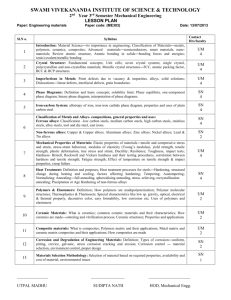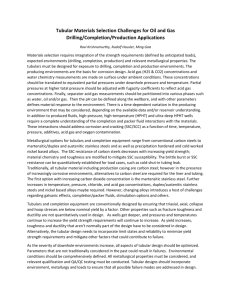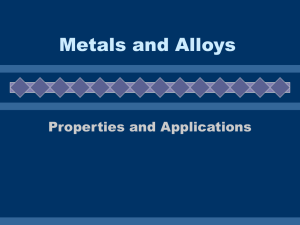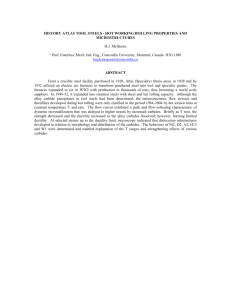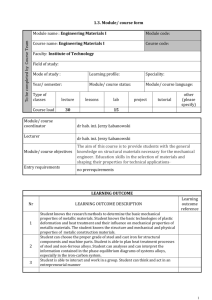Advanced metallic materials prof. Priit Kulu December 2010
advertisement
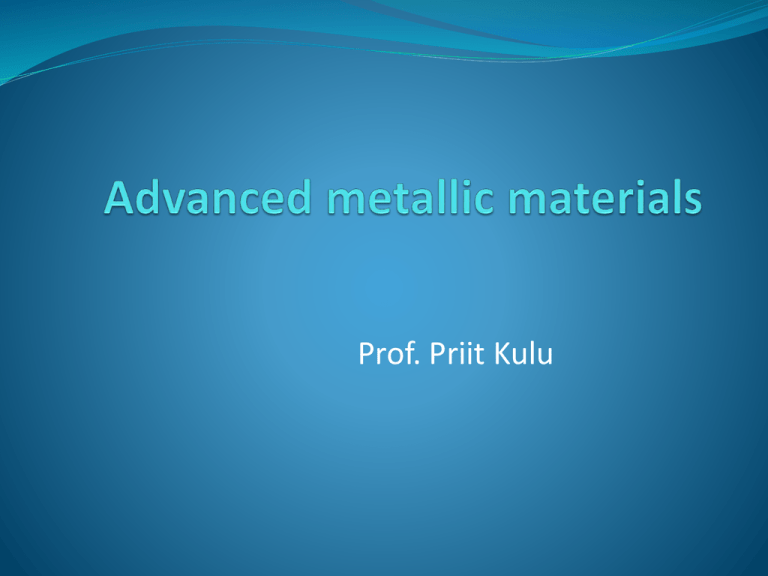
Prof. Priit Kulu Outline 1. High-strength structural steels 2. High-performance tool steels 3. Metallic-ceramic materials 4. Light-weight metals and alloys 5. Superalloys Advanced metallic materials 2 Advanced metallic materials Metallic materials with superior properties Superconductive NbTi, Nb3Sn, Nb3Ge Neodymium rare-earth magnets (alloys of Nd, Fe and B) are strongest known permanent magnets. Sm-Co magnets Structural alloys Mg- and Al-alloys with superior properties, Al-metaglass, foams Ti-alloys with thermomechanical properties, superalloys, maraging steels, intermetallides, high-density alloys, shape-memory alloys Amorphous alloys with chemical and thermal properties, Ni- and Fe aluminates Biocompatible Ti-alloys Advanced metallic materials 3 Strength groups of materials Classification based on tensile strength (Rm) of materials I. II. III. IV. Low-strength (<250 N/mm2) Mid-strength (250...750 N/mm2) High-strength (750...1500 N/mm2) Ultrahigh-strength (<1500 N/mm2) Advanced metallic materials 4 Production technologies of hihg-strength steels and alloys Advanced metallic materials 5 1. High-strength structural steels 2. High-performance tool steels 3. Metallic-ceramic materials 4. Light-weight metals and alloys 5. Superalloys Advanced metallic materials 6 High-strength steel ...what is it? The end of 1920-s Steel St 52 (S355) for bridge construction Today S355 is standard grade Definition for “high-strength” is dependent on level of development. Steel ReH > 355 MPa Advanced metallic materials 7 1. 2. 3. 4. 5. 6. Methods for increasing strength structure refinement alloying – B; microalloying elements – Nb, Ti, V and N low carbon steels transgranular fracture two- and multi-phase structures – F+M; F+M+B dispersion strengthening – micro- and nanosteels deformation hardening: Alloying of ferrite - low- & high-temperature Hardening - isothermal - marforming Alloying elements, % Advanced metallic materials Ageing Ageing time, t 8 Heat treatable boron-steels ≈ 0,003% of B increased through-hardenability 0,002...0,003% of B in solid solution has the same effect on hardenability than 0,7% Cr; 0,5% Mo or 1% Ni Through-hardenability diameter up to 200 mm C24CR Rp0,21000; Rm1500; A 7% Advanced metallic materials 9 Low-alloy high-strength steels Also known as HSLA steels C = 0,2..0,3% ; alloying el: Mn, Si Micro alloying with Nb, Ti and/or V – dispersion strengthening + grain refinement HX340LAD HX460LAD Rp0,2560; Rm640 N/mm2; A – min 15% Advanced metallic materials 10 Two- and multi-phased steels Also known as duplex (DP) and complex (CP) steels Ultra-High-strength (UHS) ductile steels - Two-phase LITEC DP Rp0,2750 N/mm2; Rm980 N/mm2; A – min 10% Advanced metallic materials 11 - Multi-phase LITEC CP Rp0,2900; Rm980 N/mm2; A – 7% DP-steel CP-steel → good formability and high strength → ability of high energy absorption → high strain-hardening rate → good fatigue strength Advanced metallic materials 12 Maraging (martensite-ageing) steels (1) Martensitic steels ( C%) - low ductility and toughness in case of high Rm - M decomposition, formation of carbide phase brittleness Maraging steels in 1980 - low C-content (0,03%) transgranular fraction - alloying el. – Ni (17...25%), Mo + Ti, Al, Ta etc. Quenching C-free martensite, Ageing intermetallides (4 – 5) nm, (NiTi, Ni3Ti, NiAl, Ni3Mo etc.) Rm 2000 N/mm2, Rp0,2 1500 N/mm2, A = 10 - 12% Advanced metallic materials 13 Maraging steels (2) Advanced metallic materials 14 Termomechanically processed / deformation hardened high temperature low temperature isothermal marforming Advanced metallic materials 15 Thermomechnical rolling 16 TRIP-steels (Transformation Induced Plasticity) Low alloy steels (car industry) 0,2 – 0,3 % C; 1,5 – 2,0 % Mn, Si + Al High alloy Ni-Cr steeks 0,2 – 0,3 % C; 8 – 32 % Ni; 8 – 14 % Cr+Mn (0,5 – 2,5%), Mo, Si Quenching (985 – 1200 °C) → F, B, A Deformation (< Trecr = 250 – 550 °C), A → M Rm →1700, Rp0,2 → 1550, A =50 – 60 %, ↑KIC, σ-1 17 Strength-plasticity of high-strength steels Rp0,2 N/mm2 KTMT TMT + def. ageing 2000 TRIP-steels TMT + def. ageing Maraging steels (highalloy) 1000 Low-alloy steels 20 40 60 60 A% 18 1. High-strength structural steels 2. High-performance tool steels 3. Metallic-ceramic materials 4. Light-weight metals and alloys 5. Superalloys Advanced metallic materials 19 Advanced tool steels (1) I generation of high-speed steels (HSS) carbide temper hardness steels 500 - 650 0C, e.g. HS 6 – 5 – 2 – 5 W-Mo -V –Co Intermetallic temper hardness steels 650 - 750 0C, Co7W6, (CoFe)7W6 etc. (11 – 20%)W; 7% Mo; (1-3%)V; (20 – 25%)Co Structure (cast and rolled) Advanced metallic materials 20 Advanced tool steels (2) II generation of high-speed steels – PM steels (PM/HIP) Uddeholmi steels Vanadis 4, 6, 10, 23, 30, 60 (Super Clean) (1,3 - 2,9%) C; → 6,5 W; (1,5 - 7%) Mo; (3,1 - 9,8%) V; → 10,5% Co Structure (PM / HIPed) Advanced metallic materials 21 Advanced tool steels (3) III generation of high-speed steels – Sprayformed, SF + HIP PM steels, Vanadis 4 EXTRA WEARTEC 2,8 C; 8,9 V; 7,0 Cr; 2,3 Mo; Si; Mn ROLTEC 1,4C; 4,6Cr; 3,7 V; 3,2 Mo; Si; Mn TOUGHTEC 1,6C; 7,2V; 5,0 Cr; 2,3 Mo; Si; Mn Advanced metallic materials 22 SF /HIP Similar to PM/HIP, slab formation by spraying methods High-Tech Materials & Technologies 23 Strength of high-speed steels TRZ, GPa Diameter of carbide particles, m Advanced metallic materials 24 1. High-strength structural steels 2. High-performance tool steels 3. Metallic-ceramic materials 4. Light-weight metals and alloys 5. Superalloys Advanced metallic materials 25 Classification of wear resistant materials depending on volumetric content of hard phase Advanced metallic materials 26 Metallic-ceramic composites Carbide steels and alloys Ferro-TiC Steel (50 - 70)% -TiC Double-reinforced MMC (Cr-steel + 20%VC) + 20%WC Self-fluxing alloys NiCrSiB + 50% (WC-Co) Ceramic/metallic TiC-NiMo – (50 - 60)% (NiMo)(2:1) 920 – 1620 HV10 Cr3C2-NiCr – (50 - 60)% NiCr Advanced metallic materials 27 1. High-strength structural steels 2. High-performance tool steels 3. Metallic-ceramic materials 4. Light-weight metals and alloys 5. Superalloys Advanced metallic materials 28 Light-weight materials – Mg alloys Mg-alloys (Mg: = 1740 kg/m3, Ts – 649 0C) Alloying elements: Al (3 - 10%); Zn, up to (5 – 6%); Mn; Zr Rm 300 N/mm2 (deformable alloys) 220 N/mm2 (cast alloy) Advanced metallic materials Rm/ 20 29 Light-weight materials – Al alloys Al-alloys Al-Li alloys (Li is only dopant, which Rm, E, however = 2500 kg/m3) 2Li, 4Mg, Rm = 220 – 350; Rp0,2 = 135 – 210 N/mm2 Powder-aluminum-alloys - dispersion strengthened Al-alloys (SAP-Al2O315%, Al- C-alloys – Al4C3 20 volume%), allowed working temperature up to 550 0C Foam-aluminum ( ~ 200 kg/m3) Advanced metallic materials 30 1. High-strength structural steels 2. High-performance tool steels 3. Metallic-ceramic materials 4. Light-weight metals and alloys 5. Superalloys Advanced metallic materials 31 Superalloys …alloys capable of service at high temperatures, usually above 1000 °C → heat-resistant high-temperature strength alloys Ni-alloys Co-alloys heat resistance (oxidation resistance > 600°C) refractory steels = heat res. + high temp. strength Advanced metallic materials 32 Ni-alloys Ni uses: ca 60% – stainless steels 12% – Ni-alloys 10% – coatings 10% – alloy steels Heat resistant alloys (superalloys) wrought (Inconel Ni – 20-23 Cr; Hastelloy Ni- 7-22 Cr-Co) cast ( polycrystalline, directionally solidified, single crystal) PM (HIP-ed, IN 100, Rene 95→ gasturbine disk) 718 (cast) Ni – (4,75 – 5,5%) Nb → aerospace, nuclear structural applications (-250 – +700 °C). MA 754 PM/HIP Ni – 1% Y2O3 Advanced metallic materials 33 Co-alloys Co uses: ca 46% – superalloys 15% – steels 10% – cemented carbides Wear resistant alloys Stellite – Co (10 –30%); Cr (1,5 –22) Ni; up to 15% W; 1 Mo Heat resistant alloys wrought Co + (20 –30%) Cr; (14 –15%) W cast Co +(23 –29%) Cr; (1 –10 %) Ni; 7 W Corrosion resistant alloys Ultimet Co + 26Cr; 9Ni; 5Mo; 2W Advanced metallic materials 34 General stress-rupture behaviour of superalloys 35 TUT materials engineering web-site: www.ttu.ee/mti mti@ttu.ee 36
